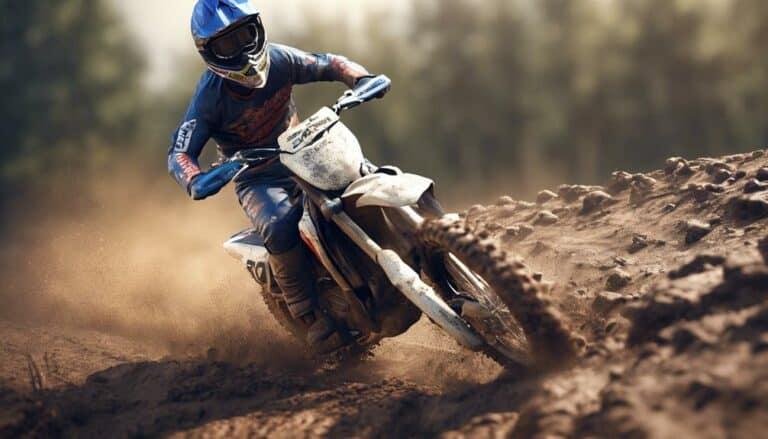When it comes to mastering dirt bike braking techniques, it's like maneuvering a winding trail—each bend in the path requires a precise touch.
But what truly sets apart skilled riders is their ability to seamlessly blend control with finesse.
By honing in on key aspects like attack position, downshifting strategies, and proper brake utilization, you can elevate your dirt biking prowess to new heights.
So, how can you fine-tune your braking skills to maneuver through rugged terrain with confidence and precision?
Key Takeaways
- Embody attack position for precise control and balance
- Utilize both brakes for maximum power and stability
- Maintain even weight distribution for improved traction
- Master brake balance for enhanced riding performance
Attack Position and Braking
Embodying the attack position on your dirt bike is essential for mastering braking techniques with precision and control. When you brake hard, the attack position guarantees that your body is aligned with the bike, optimizing your balance and control.
By using the rear brake in conjunction with the front brake lever, you can maximize your braking power. Keep your weight back, maintaining a low center of gravity that enhances stability during braking maneuvers.
Your body position in the attack stance is vital for efficient braking – lean slightly forward, elbows up, and eyes focused ahead. This alignment not only prepares you for sudden stops but also allows you to navigate corners with finesse.
The attack position isn't just about looking the part; it's about being ready to conquer any terrain with confidence and skill. Master this technique, and you'll feel the liberation of controlling your dirt bike like never before.
Downshifting Techniques for Braking
When mastering dirt bike braking techniques, understanding proper downshifting techniques is key to maximizing control and efficiency in deceleration. Downshifting before braking allows you to harness the power of engine braking, engaging lower gears for better deceleration. This technique is critical for maintaining traction and stability on varying terrains. Proper downshifting involves matching engine speed with road speed to prevent jerky movements and guarantee smoother shifts. By downshifting to an appropriate gear before braking hard, you can enhance your overall braking efficiency and control. Remember, mastering downshifting is not just about gears; it's about mastering the art of syncing your rear brake pedal, front wheel, and throttle control with your body positioning. Practice different downshifting techniques in various riding conditions to confidently tackle any terrain with finesse.
| Key Points | Benefits |
|---|---|
| Engine Braking | Maximizes deceleration capabilities |
| Smooth Shifts | Prevents jerky movements for controlled stops |
| Traction and Stability | Maintains control and stability on diverse terrains |
| Enhanced Efficiency | Improves overall braking efficiency and control |
Optimal Foot Placement for Braking
For best control and precision in your braking technique, make sure your foot is positioned slightly forward with a locked knee to maximize stability and effectiveness. Proper foot placement is key in enhancing your stability and control when applying the brakes.
Here are essential tips for optimal foot placement while braking on your dirt bike:
- Slide Your Foot Forward: Position your foot slightly ahead to establish a stable connection with the bike, allowing for better balance during braking.
- Lock Your Knee: Make sure your knee is locked while positioning your foot to optimize braking effectiveness and maintain stability.
- Enhance Balance: Adjust your foot position to secure a strong and stable foundation, enabling you to have precise control over the bike's braking system.
Effective Knee Gripping Technique
Enhance your dirt bike control and stability by mastering the art of effective knee gripping technique. When it comes to achieving the best braking performance, gripping the bike firmly with your knees is essential. By actively engaging your knees, you create a solid connection with the bike, allowing you to distribute weight evenly between the front and rear wheels. This balance is vital for maintaining stability and control, especially when applying the front brake.
Proper knee gripping technique not only enhances your ability to set up for the best braking but also enables you to absorb impacts from rough terrain more effectively. Squeezing the bike with your knees minimizes the chances of sliding out, giving you a more secure and confident feel during braking maneuvers. Additionally, consistent knee gripping promotes ideal body positioning, reducing strain on your arms and improving overall endurance during braking sessions.
Balancing Front and Rear Brakes
To achieve precise control and maximize braking efficiency on your dirt bike, mastering the balance between your front and rear brakes is paramount. When it comes to dirt bike braking techniques, understanding how to use the front and rear brakes effectively can make all the difference in your riding experience. Here's how you can achieve maximum braking prowess:
- Leverage the Front Brake: The front brake is your primary stopping power, providing up to 70% of the braking force. Utilize this brake wisely to achieve quick and efficient stops.
- Apply Both Brakes Simultaneously: Using both brakes simultaneously helps distribute the braking force evenly, stabilizing the bike and preventing nose diving. This technique enhances control and prevents skidding.
- Moderate Rear Brake Application: While the front brake is important, applying the rear brake moderately can induce wheel chatter, adding stability during braking maneuvers.
Finding the right balance between the front and rear brakes is key to mastering dirt bike braking techniques and enhancing your overall riding performance.
Conclusion
So there you have it, mastering dirt bike braking techniques is like dancing with the wind – it requires finesse, control, and perfect timing.
By perfecting your attack position, downshifting techniques, foot placement, knee gripping, and balancing front and rear brakes, you'll be able to navigate any terrain with ease and confidence.
Keep practicing, keep pushing yourself, and soon enough, you'll be braking like a pro on your dirt bike adventures. Ride on!

